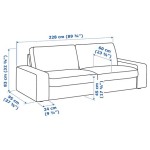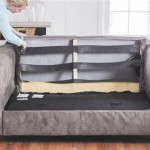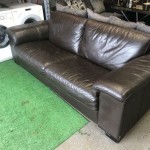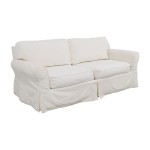How Long Will A Faux Leather Sofa Last?
The lifespan of a faux leather sofa is a question of paramount importance for consumers considering its purchase. Understanding the durability and expected longevity of faux leather, also known as pleather, leatherette, or vegan leather, allows for informed decisions and realistic expectations. While a genuine leather sofa can potentially last for decades with proper care, faux leather presents a different set of characteristics influencing its lifespan. This article aims to explore these factors, providing a comprehensive overview of the anticipated longevity of a faux leather sofa and the elements that contribute to its wear and tear.
Faux leather is a synthetic material designed to mimic the look and feel of genuine leather. It is typically constructed from a fabric base, such as polyester or cotton, coated with polyurethane (PU) or polyvinyl chloride (PVC). The coating is embossed to create a textured surface resembling the grain of real leather. The appeal of faux leather lies in its affordability, ease of cleaning, and availability in a wide range of colors and styles. However, its construction also dictates its inherent limitations regarding durability and resistance to damage.
The estimated lifespan of a faux leather sofa can vary significantly depending on several factors. These factors include the quality of the materials used in its construction, the frequency and intensity of use, the environmental conditions it is exposed to, and the care and maintenance it receives. While some faux leather sofas might only last a few years, others can potentially endure for a decade or more with diligent upkeep.
Material Quality and Construction
The quality of the faux leather material and the overall construction of the sofa are the primary determinants of its longevity. Higher-quality faux leather typically features a thicker coating and a more robust fabric backing. This combination provides greater resistance to tearing, cracking, and abrasion. The type of coating also plays a crucial role. Polyurethane (PU) based faux leather is generally considered more durable and breathable compared to polyvinyl chloride (PVC) based alternatives. PU faux leather tends to be more flexible and less prone to cracking over time.
The sofa's frame, springs, and cushioning also contribute to its overall lifespan. A solid hardwood frame provides a stable and durable foundation, while well-constructed springs offer adequate support and prevent sagging. High-density foam cushions retain their shape and resilience for longer, reducing the strain on the faux leather upholstery. Conversely, a poorly constructed sofa with a flimsy frame, weak springs, and low-density foam will accelerate the wear and tear on the faux leather, ultimately shortening its lifespan.
The stitching and seams are also critical areas to consider. Reinforced stitching and well-executed seams prevent the upholstery from separating or tearing at stress points. Loose or poorly stitched seams are more likely to fail, especially under regular use.
Usage and Environmental Factors
The way a faux leather sofa is used and the environment it is placed in can significantly impact its lifespan. A sofa that is subjected to heavy use, such as in a busy family room or a commercial setting, will naturally experience more wear and tear compared to one that is used infrequently. Frequent sitting, lying down, and general movement on the sofa can cause the faux leather to stretch, rub, and eventually crack or peel.
Environmental factors such as temperature, humidity, and exposure to sunlight can also affect the durability of faux leather. Extreme temperatures can cause the material to become brittle and more susceptible to cracking. High humidity can promote the growth of mold and mildew, which can damage the fabric backing and weaken the coating. Direct sunlight can fade the color of the faux leather and degrade its structural integrity over time. Placing a faux leather sofa in a location where it is shielded from direct sunlight and extreme temperature fluctuations can help prolong its lifespan.
The presence of pets and children in the household can also contribute to accelerated wear and tear. Pets can scratch or chew on the faux leather, while children may spill food or drinks on it. These accidental damages can compromise the integrity of the material and shorten its lifespan. Implementing preventative measures, such as using protective covers or training pets to avoid the sofa, can help mitigate these risks.
Care and Maintenance Practices
Proper care and maintenance are essential for maximizing the lifespan of a faux leather sofa. Regular cleaning and conditioning can help keep the material supple, prevent it from drying out and cracking, and remove dirt and grime that can accelerate wear and tear. The recommended cleaning methods will depend on the specific type of faux leather and the manufacturer's instructions. Generally, it is advisable to wipe down the sofa regularly with a soft, damp cloth to remove dust and spills. For more stubborn stains, a mild soap solution or a specialized faux leather cleaner can be used.
Conditioning the faux leather can help to keep it moisturized and prevent it from cracking. There are specific faux leather conditioners available on the market that are designed to nourish the material and protect it from the elements. These conditioners should be applied according to the manufacturer's instructions, typically every few months.
It is also important to avoid using harsh chemicals, abrasive cleaners, or excessive amounts of water when cleaning a faux leather sofa. These substances can damage the coating and cause it to peel or discolor. Additionally, it is advisable to protect the sofa from sharp objects, such as keys or buckles, which can scratch or tear the faux leather.
Repairing minor damages promptly can also help to extend the lifespan of a faux leather sofa. Small tears or cracks can be repaired with specialized faux leather repair kits, which are available at most hardware or home improvement stores. These kits typically include a filler material, adhesive, and color-matching compounds that can be used to patch up the damaged area. Addressing minor damages promptly prevents them from worsening and potentially requiring more extensive repairs or replacement of the upholstery.
In summary, while a precise lifespan for a faux leather sofa cannot be guaranteed due to numerous contributing factors, a general estimate ranges from 2 to 8 years with average use and care. Higher quality materials, careful maintenance, and a gentle usage environment can push that lifespan towards the upper end of the range, while poor construction, heavy use, and neglect can shorten it considerably.

Faux Leather What It Is And When To Use Or Avoid

How Long A Leather Couch Should Last Reclaimed Spring Tx

Faux Leather What It Is And When To Use Or Avoid

What Are The Advantages Of Owning A Faux Leather Sofa

Can Fabric Upholstery Be Dyed Or Refinished To Look Like Leather

Faux Leather Vs Real A Guide To Furniture

Brown Wyatt Faux Leather Sofa Kirklands Home

Oakland Faux Leather Sofa 3 Seater Furniturestop Co

Faux Leather What It Is And When To Use Or Avoid

Temple Webster Bungalow Premium 3 Seater Faux Leather Sofa
Related Posts








